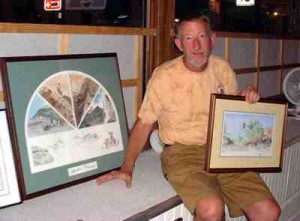Review by Ed Quillen
Colorado History – October 2005 – Colorado Central Magazine
The Colorado State Capitol – History, Politics, Preservation
by Derek R. Everett
Published in 2005 by University Press of Colorado
ISBN 0-87081-790-6
PERCHED ON A BLUFF above downtown Denver, our state capitol always struck me as a sort of generic statehouse with its pillars and arches and dome. The dome was the only thing that distinguished our capitol, since our dome, unlike any other, is covered with gold (42 ounces, to be precise). Inside, there are some impressive spaces and exquisite masonry and metalwork. There are also a lot of cramped offices, as well as worries that the structure is a fire hazard with no good way to escape a conflagration.
But as I learned while reading The Colorado State Capitol, there’s much more to the building and its story. Author Derek Everett, a Western State graduate now working on a PhD at the University of Arkansas, makes the case that the Capitol symbolizes Colorado in a way that nothing else can, and points out that just about every significant protest in state history occurred on the Capitol grounds. Furthermore, deceased leaders lie in state there; U.S. Presidents have spoken there; and of course, the legislature meets there, upstairs from the governor’s office.
Just agreeing on a capitol city took years after Colorado Territory was established in 1861. It was in Denver at first, but moved around to Golden and Colorado City (not the current one west of Pueblo, but the old one on the west side of Colorado Springs, and now annexed into that city). Pioneer legislators preferred the accommodations in Denver to the more primitive inns and taverns elsewhere, and so the territorial government generally rented space in Denver.
But after statehood in 1876, the new state constitution specified that no funds could be spent on a capitol building until the city had been determined by a public vote, which didn’t happen until 1881. Denver won handily, defeating Pueblo, Colorado Springs, Cañon City, and Salida — all more centrally located.
THAT DIDN’T HAPPEN soon enough to suit Henry C. Brown, who in 1869 had donated 10 acres just outside early Denver, “Brown’s Bluff,” for a capitol building. By 1881, he had sued several times to get his land back, since there had been no progress toward construction on the site.
He would sue again before construction finally started in 1886. The legislature set up a Board of Capitol Managers (dominated for years by Saguache pioneer Otto Mears) to oversee construction, and they held a design competition. The winner, Elijah Meyers, had no formal architectural training, but he had designed the capitols of Michigan and Texas.
Name anything associated with a big government job — cost over-runs, delays, incompetent patronage appointees, questionable contracts with suppliers — and you’ll find it in Everett’s account of the decade it took to build the structure.
The capitol managers did meet one goal: just about every piece of the Capitol came from Colorado. Central Colorado contributed the onyx trim stone from a quarry near Beulah, and the granite exterior walls were hauled by the trainload from the Aberdeen Quarry southwest of Gunnison.
One reason for the frequent delays was transportation. Railroads served some quarries, but others, like the marble quarry on the Crystal River, did not have service then, and wagons in rough country were slow.
The Capitol finally opened, for at least a few offices, in 1894, and others moved in soon afterward. It was designed to be big enough to house the entire state government with chambers for both houses of the legislature and the supreme court, and office space for the governor and the executive departments.
IN SEVERAL PLACES, author Derek Everett explains something I had never given much thought to: the symbolism imbued in the Capitol’s design:
“The designs of the Colorado statehouse also expressed the American principle of favoring representation over individual authority. Like many other capitol buildings across the nation, Myers placed executive officials on the lower floors, whereas the legislature sits symbolically above the governor. For most of the building’s history the executive office has blended inauspiciously with the other rooms on the first floor, deserving of no more or less attention than any other.”
As the state’s population grew, the state’s government grew too, and state office buildings were constructed nearby. Meanwhile the Capitol has started to show its age, and Everett makes a good argument for a thorough restoration and modernization. In his view, it isn’t just an office of government, but the symbolic center for the people of Colorado, the physical representation of our identity as citizens of “one of those big square states out west,” and we ought to have something we can be proud of.
Never again will I see our state Capitol as merely a relic built for different times. Instead, it houses its own stories (like the hidden microphones once planted in the governor’s office by his political opponents), as well as the story of Colorado’s aspirations and desperations in the 144 years since Colorado Territory was proclaimed by President Abraham Lincoln.
This book isn’t casual reading; the writing can get pretty dense, even for a history buff like me. But it’s well worth reading, for it’s a detailed account of a place that is important to all of us in Colorado, no matter how much distance we put between ourselves and our Capitol.

